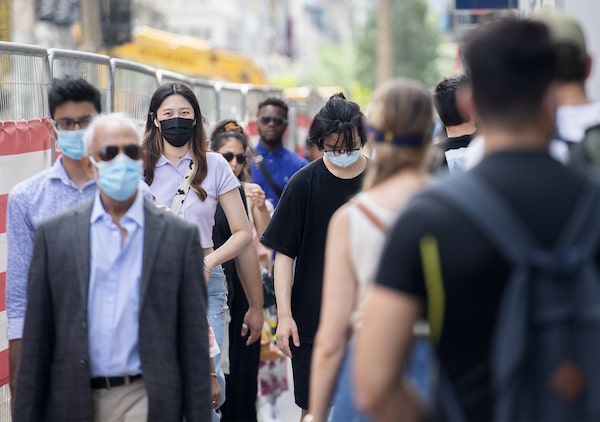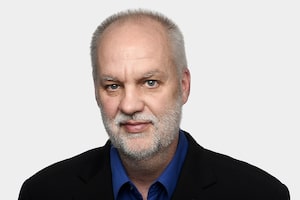
People wear face masks as they walk along a street in Montreal on June 13, 2021.Graham Hughes/The Canadian Press
Given the devastating impacts of the triple-headed monster – respiratory syncytial virus, influenza and SARS-CoV-2 – on children and pediatric hospitals, is it justifiable to have mandatory masking in public spaces again?
Almost certainly, yes.
Is it going to happen? Almost certainly, no.
Welcome to the frustrating incongruity of (post-?) pandemic life.
A mask mandate makes sense scientifically. But it’s pretty well a non-starter for political and social reasons.
Most politicians and public health officials would just as soon lay their heads on the tracks of an oncoming train before telling people that they can’t go to work, school, the shopping mall, or church without a face covering.
Masking was widely embraced earlier in the pandemic – before vaccines, and before most people were infected with COVID-19 during one of the eight or so waves that have washed over the country.
“Toto, I have a feeling we’re not in 2020 any more,” to paraphrase Dorothy in The Wizard of Oz. Solidarity has largely gone out the window. The zeitgeist is: everyone for themselves.
People are largely sick and tired of pandemic rules and restrictions, even largely effortless gestures such as donning face coverings in public spaces.
The maskless are not evil. There are multiple reasons they’ve thrown in the towel (or the surgical mask or N95). Peer pressure is powerful. Nobody else is masking, so why should I? There is the fear of the slippery slope: if masking is mandated, what’s next – a return of vaccine mandates, and lockdowns?
The messaging around masks has also been confusing at best.
At the outset of the pandemic, we were told masking was to be avoided, that research shows masks make you touch your face and increase the risk of infection. Masks were for health professionals, trained in donning and doffing. Then came mask shortages, and the do-it-yourself era of cloth masks. (Who doesn’t have a box of those in the cupboard?)
Scientific consensus shifted rather quickly and soon masks were mandated in all public spaces. Except in schools, where we argued about the impact on learning, and whether kids actually get sick. (That question has been answered in spades.) Then we bickered about the relative merits of various sorts of masks, and where they should be used. Gradually, restrictions were lifted everywhere.
We can forgive the public for being a bit confused, or skeptical about masking and mask mandates. The messaging has been and continues to be all over the map.
Recently, politicians and public health officials have been doing a lot of “urging” about mask-wearing, but are backing it up with some contradictory role modelling.
Ontario Premier Doug Ford encouraged everyone to mask up in indoor public spaces, but he and most of his colleagues remained unmasked in the legislature. Dr. Kieran Moore, Ontario’s chief medical officer of health, “strongly recommended” masking, especially at indoor gatherings. Then he was photographed unmasked at a Toronto Life party.
Neither of those is a good look. But the reality is that masking is a personal choice, whether we like it or not. Public shaming is not an effective tool.
Overstating the potential impact of a mandate isn’t helpful, either. Legislating mask-wearing in public might slow the spread of respiratory viruses but it would not magically end the crisis in pediatric hospitals.
One of the big unknowns is adherence. Would people actually wear masks in public if it was mandated? If not, how would we enforce the rule?
If there is one overarching lesson of the pandemic, it is that no one public health measure works in isolation. Vaccination, physical distancing, mask-wearing, staying home when you’re sick, and even handwashing all make a bit of a difference.
But public buy-in matters most.
Public health, even more so than politics, is the art of the possible.
We’re at the point in the pandemic where pragmatism will have to do. Urge people to embrace mitigation measures, and remind them of the benefits of acting, and the cost of inaction.
There was virtually no flu when the vast majority of people were wearing masks and avoiding large gatherings. Our laissez-faire attitude means hospitals are full of sick kids, and one of them could be your child or grandchild.
The core philosophy of public health is harm reduction. Meet people where they’re at, whether it’s substance use or mask-wearing. Give them the tools and the knowledge to protect themselves and others, and hope they use them at least sometimes.
And don’t let perfect be the enemy of good.
 André Picard
André Picard